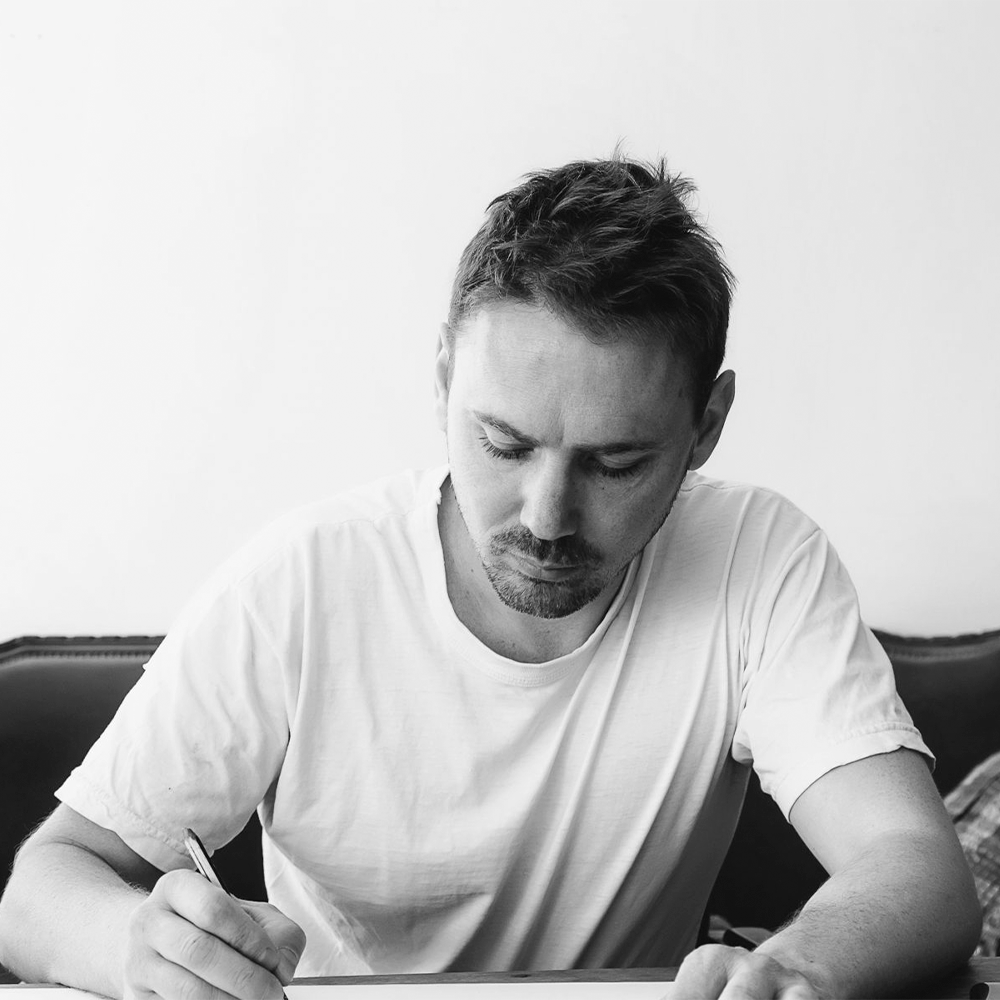
Eduardo Basualdo
He was born in Buenos Aires in 1977. He studied Fine Arts at the National Institute of Visual Arts (UNA) and continued his education through various national and international study grants: the Kuitca Fellowship (Buenos Aires), Scowhegan School of Painting and Sculpture (Maine, United States), and SAM Art Project (Paris, France). He has participated in events at public and private institutions in different cities around the world.
In 2014, he exhibited his work "Teoría (La cabeza de Goliat)" at the Palais de Tokyo (Paris) and was selected by curator Okwui Enwezor to participate in the 56th Venice Biennale (2016). He also participated in the Gwangju Biennale (2014), the Lyon Biennale (2011), the Mercosur Biennial in Porto Alegre (2009), and the Pontevedra Biennial (2006).
His work is part of various public and private collections, including: Hirshhorn Museum, Washington DC; Musée d´Art Contemporain de Lyon; Musée des Beaux-Arts de Montreal; Musée d´Art Contemporain de la Haute-Vienne; Château de Rochechouart, Rochechouart; Les Abattoirs, Musée – Frac Occitanie, Toulouse; CiFo (Cisneros Fontanals Art Foundation), Miami; Museo de Arte Moderno de Buenos Aires; Banco Supervielle, Buenos Aires; Adrastus Collection, Arévalo; and Juan y Patricia Vergez, Buenos Aires. He is a member of the experimental art collective Provisorio-Permanente.
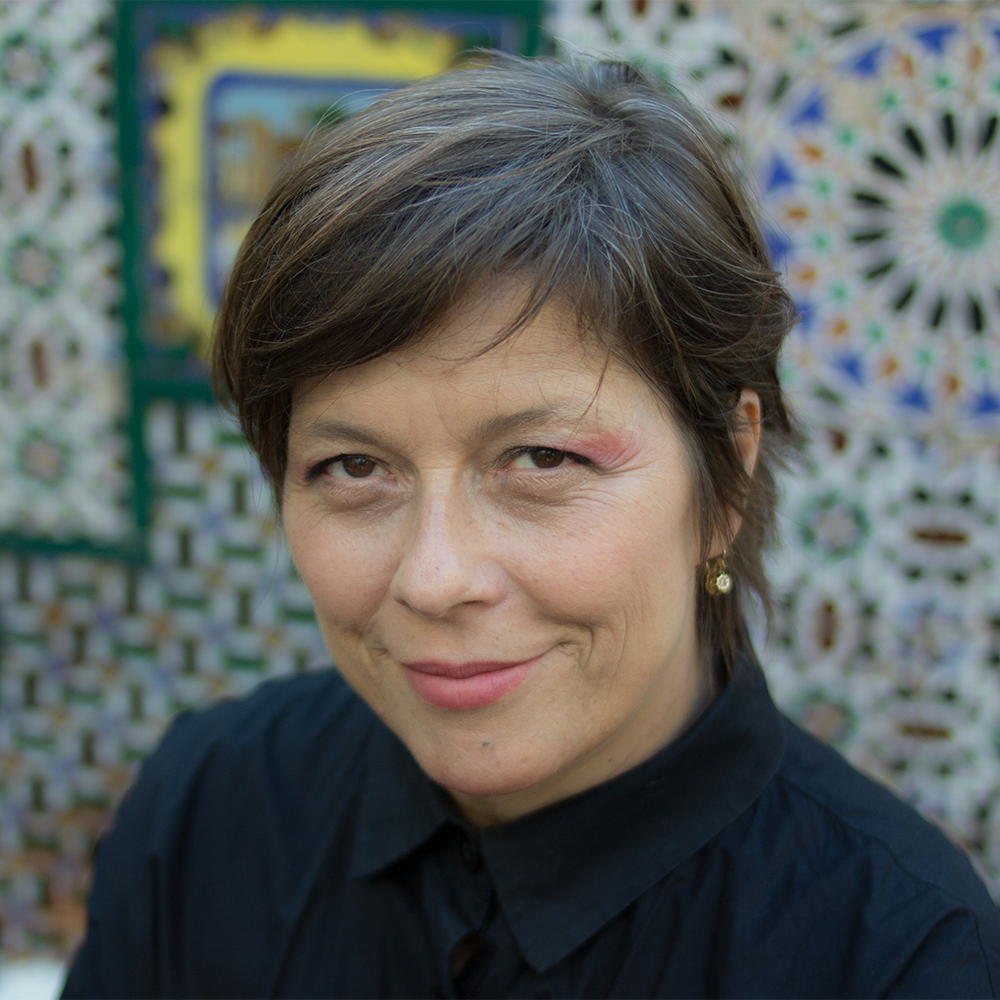
Mariana Bellotto
Born in Mar del Plata, province of Buenos Aires, in 1963. She is a choreographer. She develops a prolific and original authorial work from a perspective of the body as a critical and political vehicle. She uses a hybrid language that combines dance, performance, dramaturgy, sound design, and audiovisual media to create in multiple formats and supports. In the 1980s, she was part of the Dance Theater Group of the UBA, at the Centro Cultural Rojas. She created and directed groups such as La piedra de la locura in the 1990s, and Compañía Eléctrica and La compañía in the 2000s. Since 2015, she has been actively involved in collective artistic creation and production with the Grupo Performático Sur. They are the authors of Sensación Térmica (2015); Contemporary Anthropology of the Landscape (2016); MOEBIUS (2017); Pandemic Trilogy (2021), Standby (2022), and Mundo de mierda (2023). She presented her works at Fundación Santander; Performance Biennial; BIENALSUR; Teatro Colón's Experimentation Center; Unsam's Center for the Arts; Malba; Arthaus; and at the Cultural Center of Valparaíso; National Dance Center, Paris; Cervantes Institute, Tokyo; Central University of Venezuela; Panorama, Rio de Janeiro; NC-arte Foundation, Bogotá; Ocampo Theater, Cuernavaca; Busan International Festival, and Tanzhaus nrw, Düsseldorf, among others.
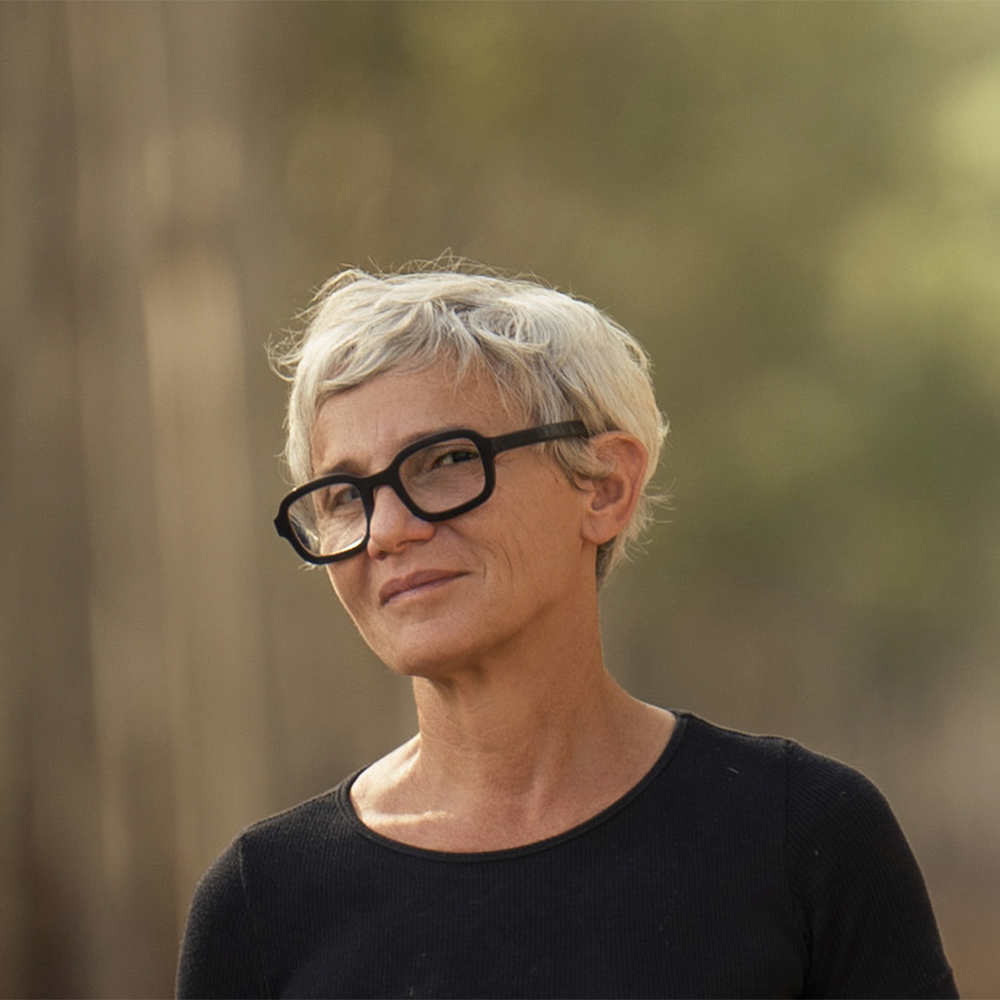
Adriana Bustos
Born in Bahía Blanca, province of Buenos Aires, in 1965. He studied art and psychology at the National University of Córdoba. The investigative and documentary nature of his work makes photography, video, painting, performance, and primarily drawing the most relevant media in his production. He has participated in the Green Sanake biennials; TaiKuwn Museum, Bihar Museum, and Sharjah Biennial, United Arab Emirates (2018); Dhaka Art Summit, Bangladesh (2019); Montevideo Biennial (2019-2014); Sur Global Biennial (2017-2023); Asunción Biennial (2015); Site Santa Fe, USA (2014); Rennes Biennial, France (2012); Istanbul Biennial (2012); Medellín International Encounter (2011); End of the World Biennial, Ushuaia (2009); Mercosur Biennial (2005), India (2023), and Hong Kong (2024). He received the Konex Platinum Award (2022); Azquy Award (2019), and the First Federico Klemm Prize for Visual Arts (2016). In 2004, 2005, and 2006, he received awards from Cultural Chandon, OSDE Photography Prize 2006, and Andreani Prize 2008. He has participated in numerous exhibitions in Argentina and abroad: George Pompidou Art Center; Madre Museum in Naples; Museo della Civiltá in Rome; Museum of Modern Art in Buenos Aires; Mambo: Museum of Modern Art in Bogotá, Musac: Museum of Contemporary Art of Castilla y León, Spain, among others. His works are part of the collections of the Reina Sofía Museum; Arco Ifem Foundation; Kadif Foundation; Museo della Civiltá in Rome; Malba; Museum of Modern Art; Macro; Aciacity Foundation; Banco de la República de Colombia; Federico Klemm Foundation; OSDE Foundation; Museum of Contemporary Art in Lisbon; National Arts Fund; Museum of Contemporary Art in Medellín and Cassa de Rizparmio Foundation, Modena, among others.
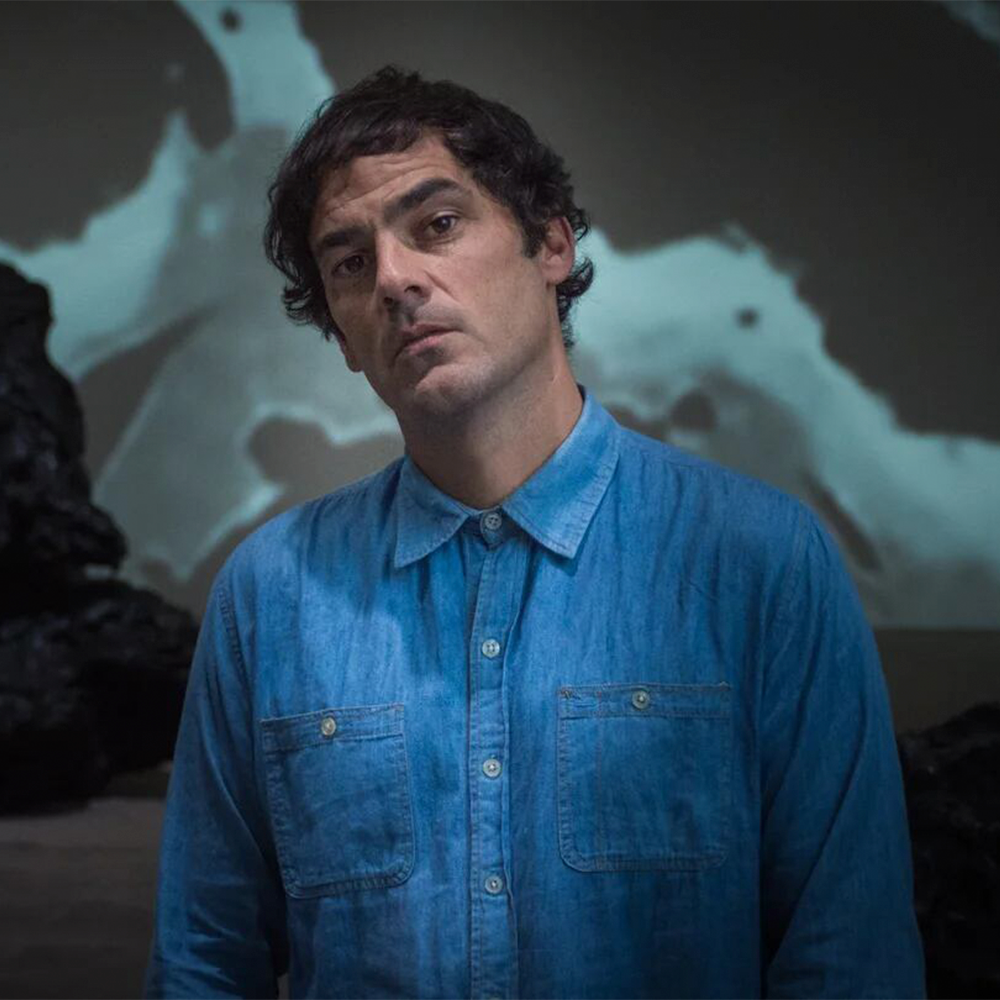
Matías Duville
Born in Buenos Aires in 1974. He studied at the Escuela Superior de Artes Visuales Martín Malharro in Mar del Plata. He participated in various scholarships: for Production and Analysis of work granted by the Antorchas Foundation (1999) and the Scholarship for Plastic Arts from the National Fund for the Arts (2001-2002); the Kuitca Scholarship from the Centro Cultural Rojas (2003) and the Guggenheim Scholarship (2011).
He attended residency programs in the United States, Brazil, and Italy. He exhibited his work at Galería Alberto Sendrós (Buenos Aires, 2003); Galería Baró Cruz (São Paulo, 2006); Museo de Arte Contemporáneo de Castilla y León (Spain, 2007); Galería Distrito 4 in Madrid (2009); Galería Luisa Strina (São Paulo, 2010); Galería Nueveochenta (Bogotá, 2011); Centro Cultural Recoleta (2016) and at Galería Barro (2017), both in Buenos Aires.
His work is part of the collections of Pathy Cisneros, New York; ARCO Foundation, Madrid; Museo de Arte Contemporáneo de Castilla y León, Spain; Blanton Museum, Houston, Texas; Museo de Arte de Lima; Museo de Arte Latinoamericano de Buenos Aires, and Museo de Arte Contemporáneo de Rosario, Argentina.
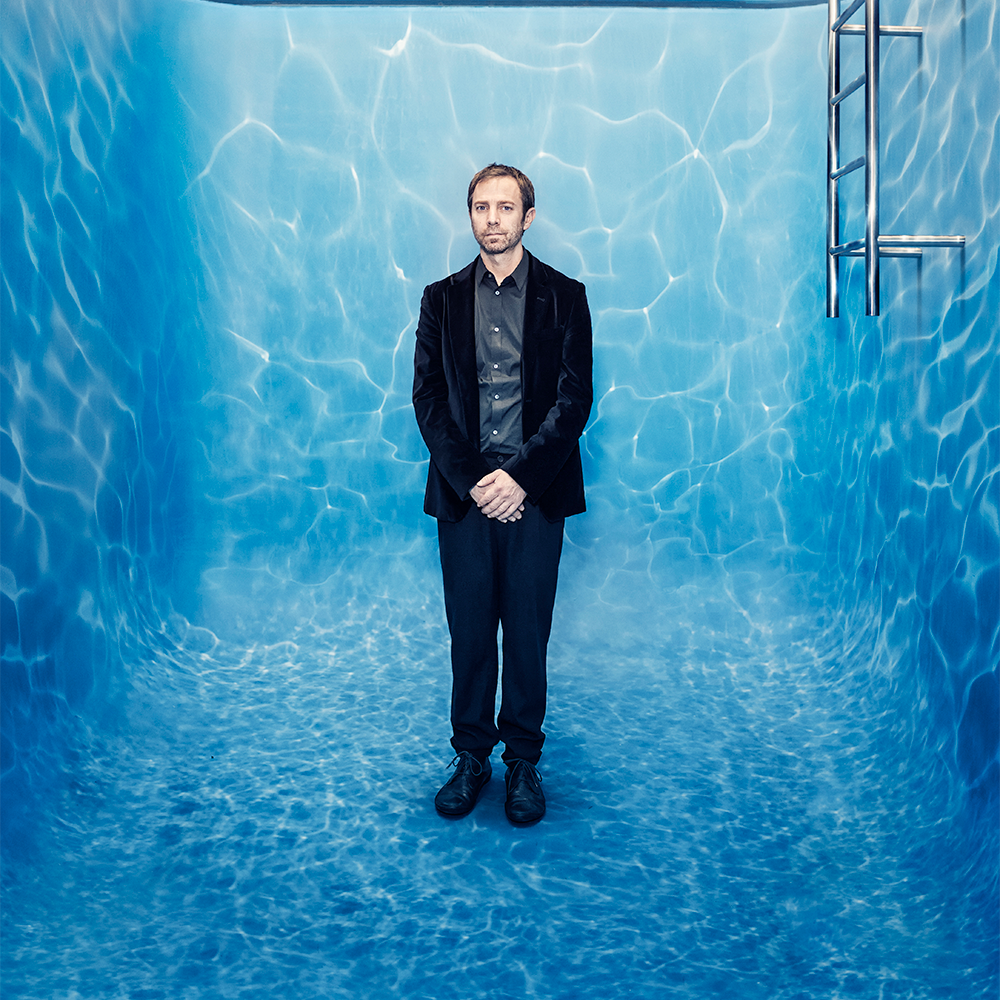
Leandro Erlich
He was born in Buenos Aires in 1973. He studied at the National School of Fine Arts Prilidiano Pueyrredón. Over the past two decades, his work has been exhibited internationally and is included in the permanent collections of prestigious museums and private collectors, among them: Museo de Arte Moderno, Buenos Aires; The Museum of Fine Arts, Houston; Tate Modern, London; Musée National d'Art Moderne, Centre Georges Pompidou, Paris; 21st Century Museum of Art Kanazawa, Japan; MACRO, Rome and Museum of Jerusalem, among others.
He is the author of La democracia del símbolo at the Obelisk and the Malba Museum in Buenos Aires; Maison fond for the UN Conference on Climate Change in Paris; Bâtiment at Nuit Blanche Paris, Ball game for the Youth Summer Olympics in Buenos Aires, Port of Reflections exhibited at MMCA in Seoul and Palimpsesto at the Echigo-Tsumari Art Triennial in Japan.
Currently, his monumental work La carte will be permanently installed in the city of Bordeaux, France. He participated in exhibitions at Cafam in Beijing, the Malba in Buenos Aires, CCBB in several cities in Brazil, PAMM in Miami, Centre Pompidou Metz in Paris. As a conceptual artist, his work explores the perceptual foundations of reality and the ability to question what we believe and what we see, while also seeking to bridge the gap between the museum or gallery space and everyday experience.
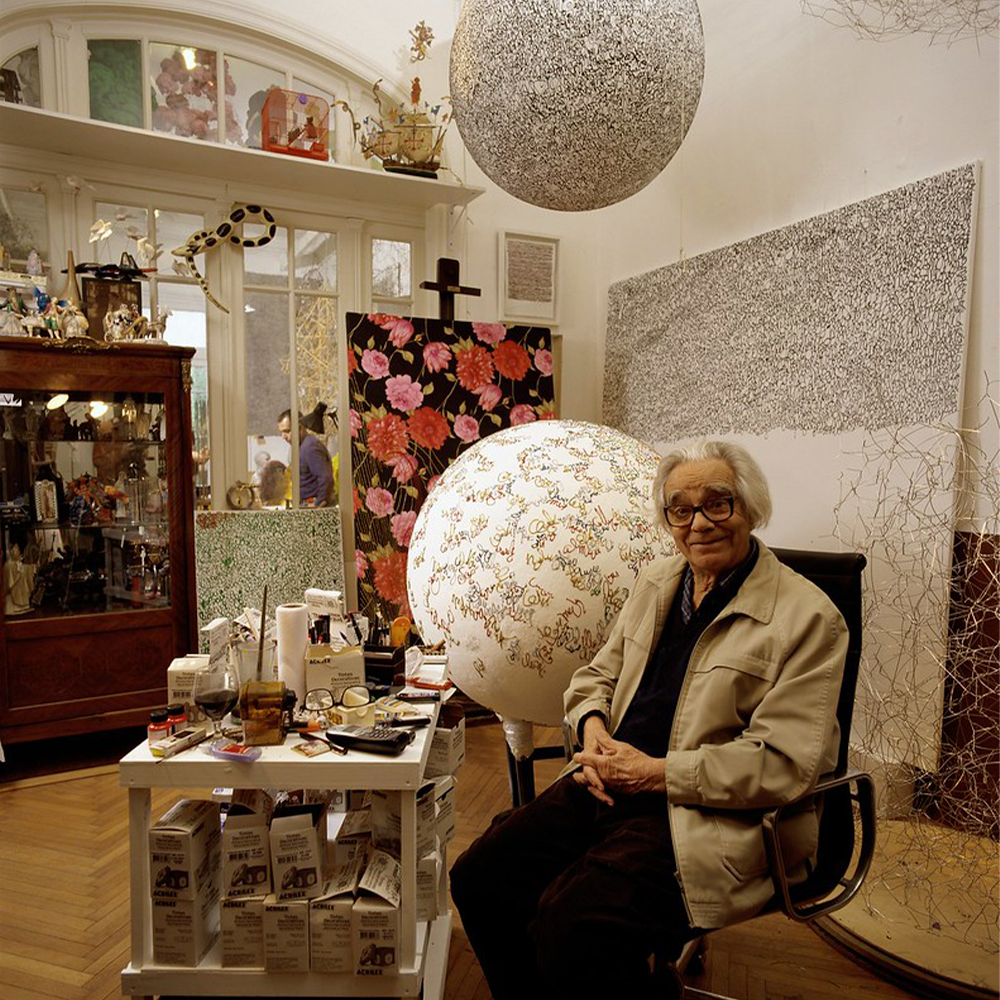
He was born in Buenos Aires in 1920. An engineer and self-taught artist, he began working with ceramics in the 1950s before incorporating various materials and supports. He later developed the so-called "abstract writings," also known as "written drawings".
In 1965, he produced one of his most controversial works: The Western and Christian Civilization. In the mid-1970s, he went into exile with his family in São Paulo, Brazil, where he continued to produce actively with a strong presence in the local scene until the 1990s, when he returned to Argentina. From the exhibition "Hells and Idolatries" (Institute of Ibero-American Cooperation, 2000) and the retrospective in 2004 at the Centro Cultural Recoleta, his name gained great visibility due to the challenging imprint of his works regarding institutions.
In 2007, he was awarded the Golden Lion at the 52nd Venice Biennale. The following year, together with his family, he created the Augusto and León Ferrari Art and Heritage Foundation to preserve his legacy and that of his father. According to The New York Times, at the time of his death on July 25, 2013 (at the age of 93), León Ferrari was one of the most provocative and important visual artists in the world. To celebrate the centenary of his birth (2020), two major panoramic exhibitions are planned: "Recurrences" at the National Museum of Fine Arts, finally presented in 2023 due to the pandemic, and "The Kind Cruelty," a panoramic exhibition inaugurated in 2021 at the Reina Sofia Museum (Spain), which travels through Europe to the Van Abbemuseum (Netherlands) and the Centre George Pompidou (France).
He passed away in Buenos Aires in 2013.
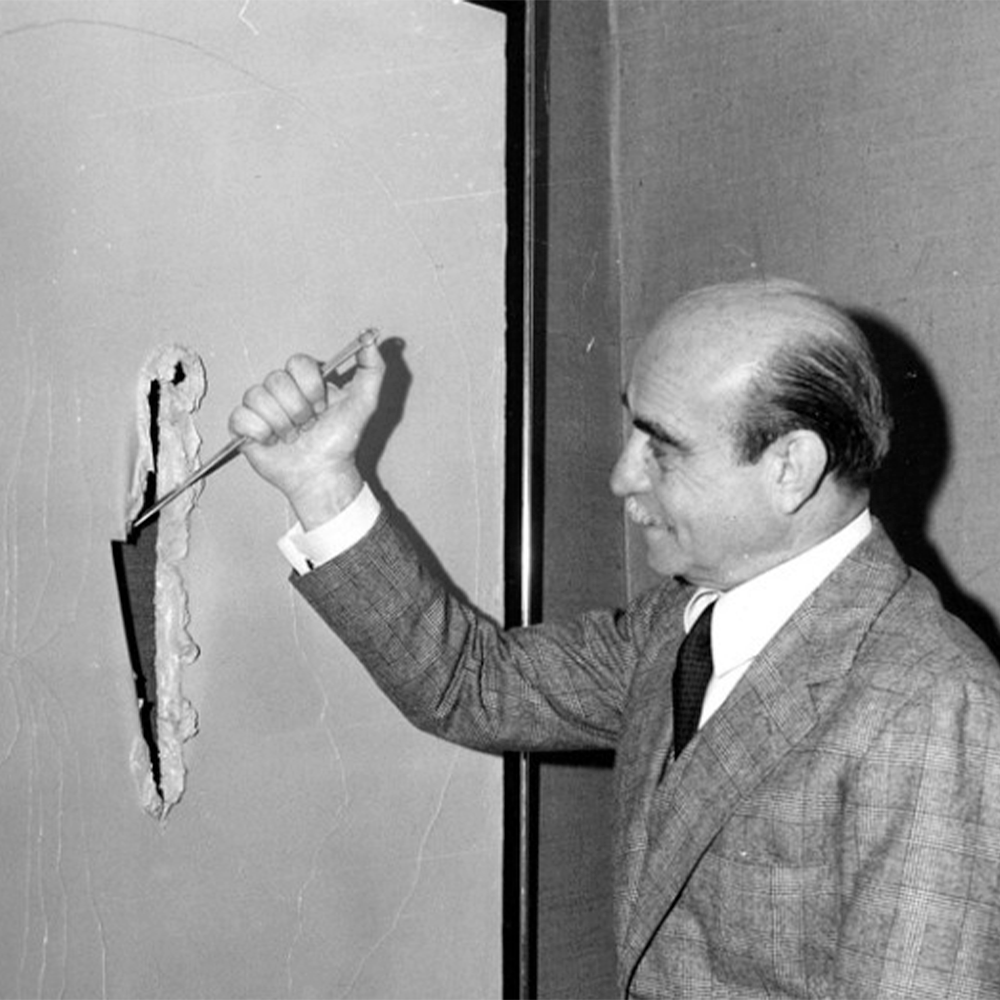
Lucio Fontana
He was born in Rosario, Santa Fe province, in 1899. At the age of six, he moved to Milan. In 1922, he returned to Argentina and worked in his father's workshop dedicated to funerary sculpture.
Towards the end of the decade, he returned to Italy and took classes with Adolfo Wildt at the Brera Academy. In 1934, he worked with bifacial structures, exhibited in 1935 at the first collective exhibition of Italian abstract art in Turin. He joined the group "Abstraction-Creation. Art non figuratif" in Paris. He proposed a project for the International Competition for the Monument to General Julio A. Roca, and in 1936 he presented drawings and engravings at the Moody Gallery in Buenos Aires. During World War II, he settled in Buenos Aires, created the monument El sembrador in Rosario, and collaborated on the projects for the National Flag Monument and the General San Martín Monument in Quilmes, Buenos Aires. He exhibited at the Müller Gallery, Impulso, the Municipal Museum of Santa Fe, and participated in collective exhibitions and salons. He taught at the School of Plastic Arts in Rosario, the Prilidiano Pueyrredón School of Fine Arts, the Manuel Belgrano School, and the Altamira Free School of Plastic Arts, an institution he organized with Emilio Pettoruti, Jorge Romero Brest, and Jorge Larco. Although his production until 1946 showed a marked figurative accent, between October and November of 1946 he adhered to the White Manifesto.
In 1942, he won the First Prize in Sculpture at the XXXII National Salon, and in 1945 he joined the Independent Salon. Back in Milan, he subscribed to the I Manifesto of Spatialism with the participation of Giorgo Kaisserlian, Beniamino Joppolo, and Milena Milani. In 1948, he signed the II Manifesto of Spatialism with Kaisserlian, Joppolo, Milani, and Antonio Tullier and presented Spatial Sculpture at the Venice International Art Biennale. The following year, he created the Space Environment with Black Light at the Galleria del Naviglio, and then, deepening his spatial search in the pictorial field, he created the first "holes." In 1950, he participated in the "International Exhibition of Modern Drawing" held in Bergamo, and in the competition for the fifth door of the Milan Cathedral. In 1951, he signed the IV Manifesto of Spatial Art. Then followed the cycles of "Stones" (works with the application of glass), "Inks," and "Papers."
In 1959, he exhibited the "Cuts" cycle at the Galleria del Naviglio and at the Galerie Stadler in Paris, proposing the physical rupture of the pictorial plane. In 1964, Enrique Crispolti organized a "Tribute to Fontana" within the scope of the international review Aspetti dell'arte contemporanea, and in 1966, the Museum of Modern Art in New York organized the traveling exhibition "Alberto Burri and Lucio Fontana." In Argentina, noteworthy were the exhibitions presented at the Torcuato Di Tella Institute in Buenos Aires (1966) and at the Municipal Museum Juan B. Castagnino in Rosario (1966).
He passed away in Varese, Italy, in September 1968.
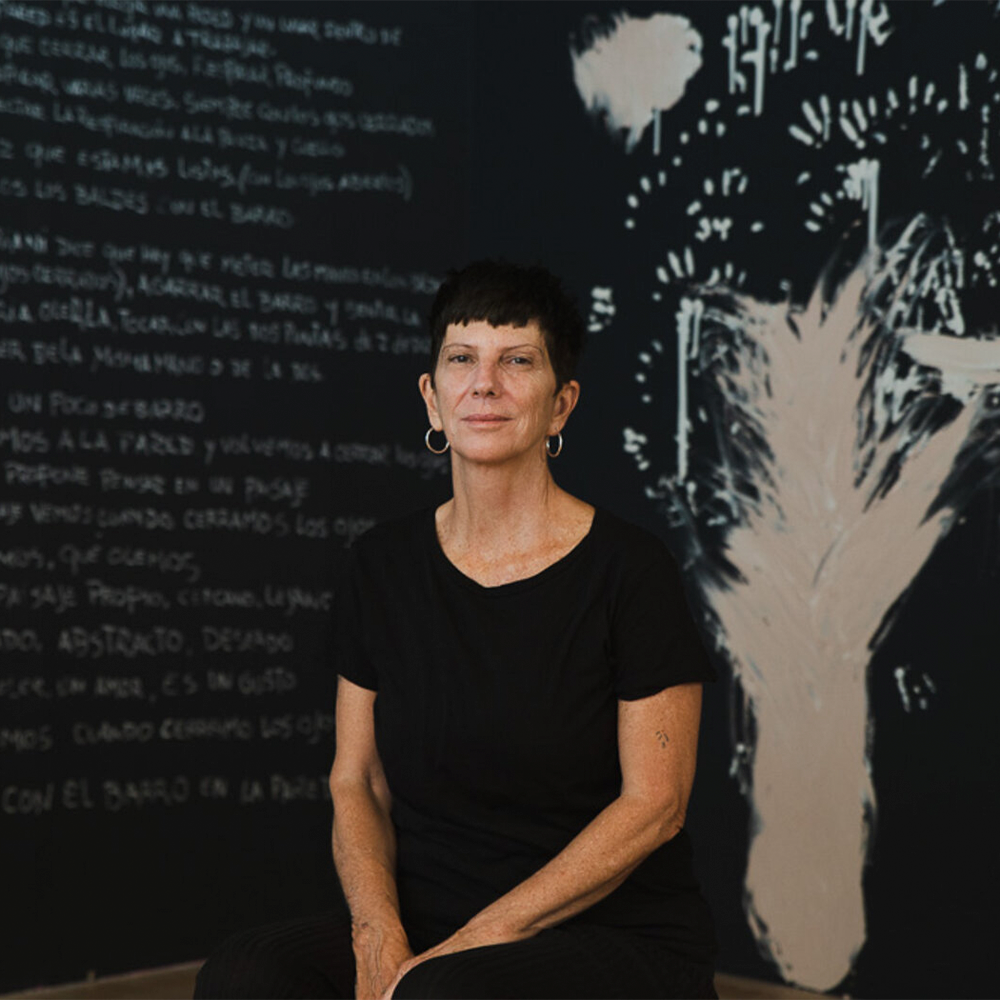
Ana Gallardo
Born in Rosario, province of Santa Fe, in 1958. She is a self-taught artist. She attended workshops by Miguel Dávila, Víctor Grippo, and Juan Doffo. In the 1980s, she was part of the Grupo de la X, formed by Jorge Macchi, Juan Paparella, Pablo Siquier, and Ernesto Ballesteros, among others, with whom she exhibited in 1987.
Among other distinctions, she received an honorable mention in the Banco Nación Visual Arts Award in 2000, and in 2001, an honorable mention in the V Klemm Award. She has received numerous national and international grants and participated as an artist and curator in collective and individual exhibitions in Rosario, Buenos Aires, and Mexico. For several years, she has exhibited internationally and in 2015 participated in the 56th International Venice Biennale. Throughout her career, she has managed projects to support the training and visibility of young Argentine artists.
In parallel with her artistic production, she has developed independent projects aimed at promoting local art, making visible practices that do not enter commercial or institutional circuits, and linking women artists from different generations. In 2005 and 2006, she organized Periférica, the first fair of self-managed spaces by artists. She participated in Espacio Forest (2013), La Verdi, and La Verdi Mexico.
Her practice addresses art as a transformative tool and explores the role and dialogue between contemporary art and the art institution.
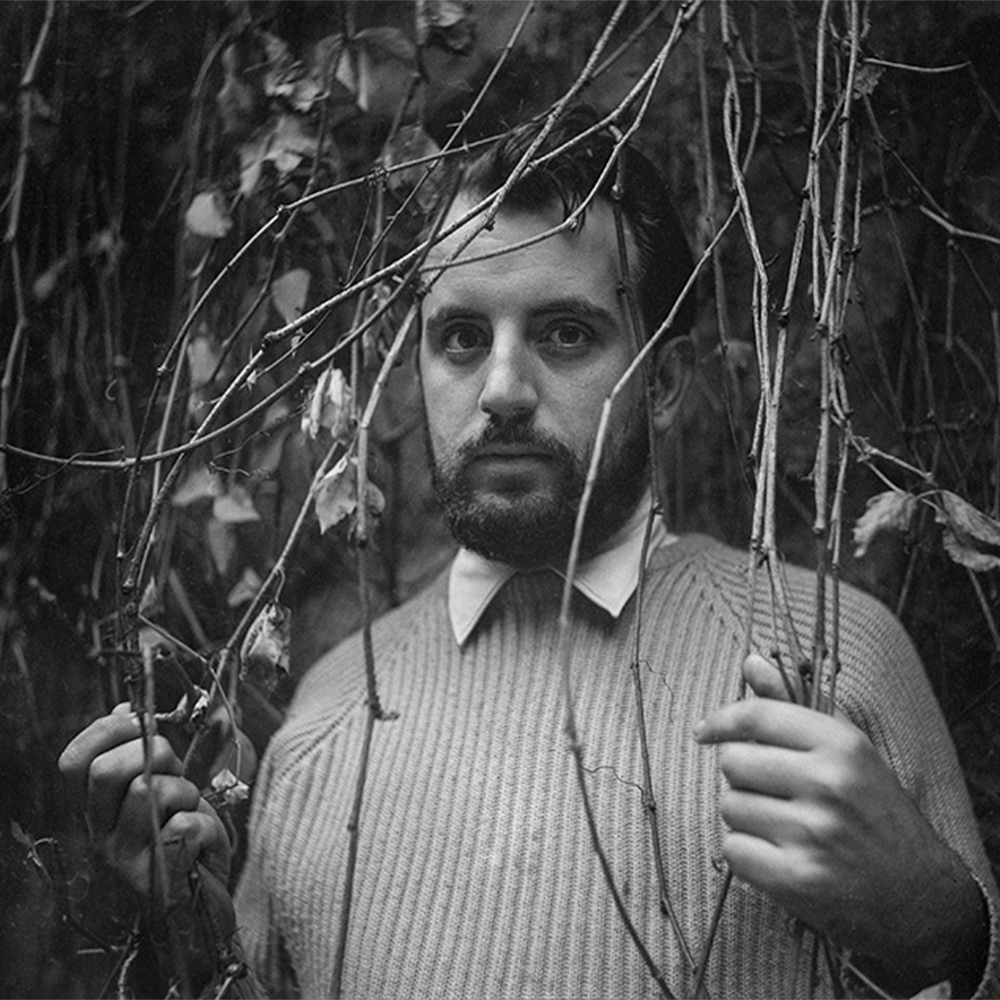
Alberto Greco
He was born in Buenos Aires in 1931. He studied for a brief period at the National School of Fine Arts Manuel Belgrano and then, from 1947 to 1948, attended the workshops of Cecilia Marcovich and Tomás Maldonado. In 1950, he published his book Fiesta. In 1954, he received a scholarship from the French government and settled in Paris, where he held his first solo exhibition in 1955, at the La Roue gallery. He returned to Buenos Aires the following year and exhibited his Parisian works at the Antígona gallery. In 1957, he traveled to Rio de Janeiro and the following year to São Paulo, Brazil, where he exhibited individually at the Museum of Modern Art. In 1959, he joined the Argentine informalist movement along with Kenneth Kemble, Enrique Barilari, Olga López, Towas, Fernando Maza, Luis Alberto Wells, and Mario Pucciarelli. In 1961, he presented his exhibition "Las monjas" at the Pizarro Gallery in Buenos Aires and covered the walls of downtown Buenos Aires with posters bearing the text "Alberto Greco, how great you are". In 1962, he held the "Première Exposition Arte Vivo" in Paris, encircling people, objects, and situations with chalk and signing them. That same year, in Genoa, he published his "Manifiesto Dito dell’Arte Vivo" in Italian, which he pasted on the city's walls. He coined the term Vivo-Dito to refer to his actions of living art.
In 1963, he presented his show Cristo 63. Omaggio a James Joyce at the Teatro Laboratorio in Rome, in collaboration with Carmelo Bene and Giuseppe Lenti. The scandal generated by the work precipitated his departure from Italy. He traveled to Madrid, Spain, and later to the town of Piedralaves, in Ávila, where he carried out a series of actions photographed by Montserrat Santamaría. Also in Piedralaves, he created his Grand manifesto-roll arte Vivo-Dito. In 1964, he exhibited at the Juana Mordó gallery in Madrid and returned to Buenos Aires, where he presented Mi Madrid querido. A painting spectacle vivo-dito with the participation of Antonio Gades. In 1965, he participated in New York in an action organized by Arman, Robert Filllou, and Daniel Spoerri, called by Greco Rifa Vivo-Dito at Central Station. He returned to Spain and spent some time in Ibiza, where he began writing his novel Besos brujos. In October 1965, he settled in Barcelona, where he ended his life before turning thirty-five.
In 1991, the Valencian Institute of Modern Art (IVAM) presented the largest exhibition of Alberto Greco, curated by the Spanish critic Francisco Rivas; a year later, the exhibition was shown at the National Museum of Fine Arts in Buenos Aires, Argentina.
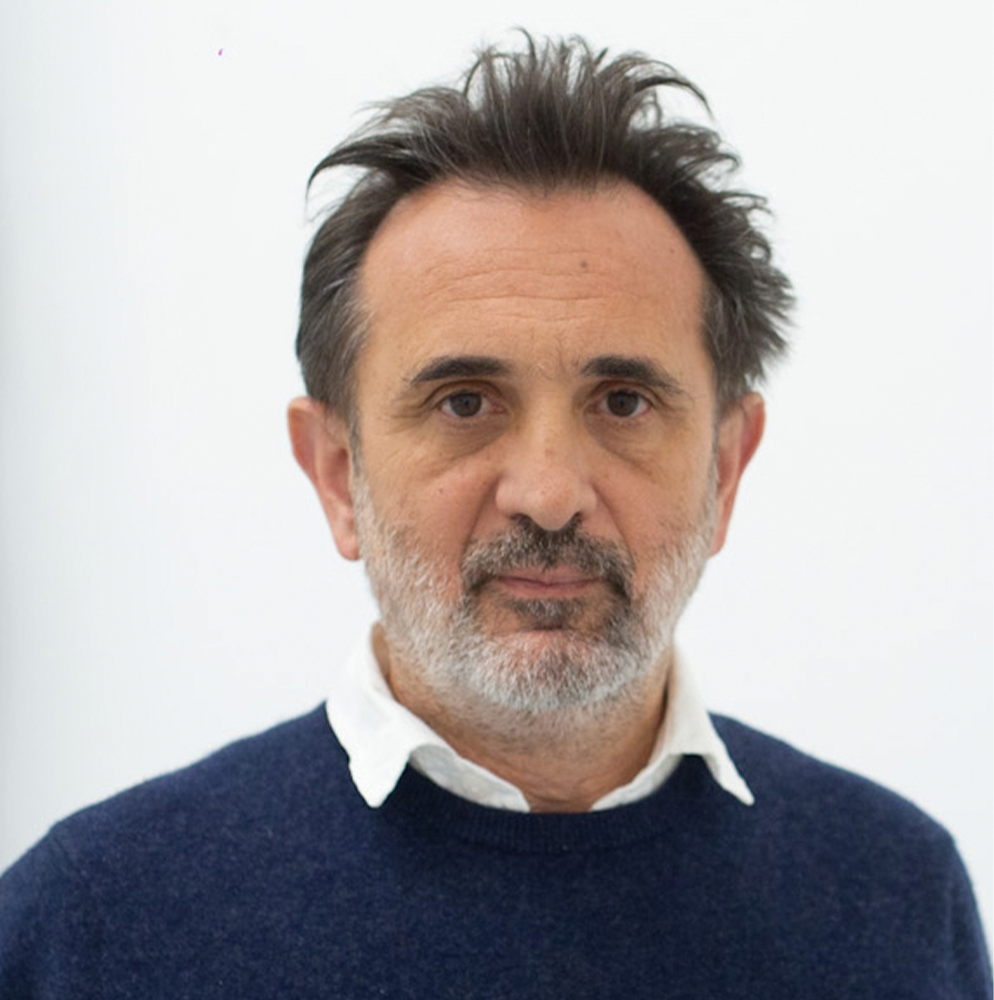
Jorge Macchi
He was born in Buenos Aires in 1963. He studied at the National School of Fine Arts in Buenos Aires. In 2000, he received the Banco de la Nación Argentina Award. In 2001, he was awarded the John Simon Guggenheim Memorial Foundation Fellowship. He participated in artist residency programs in the United States (Artpace, 2005), Italy (Civitella Ranieri, 2002), Germany (Schloss Pluschow, 1998), England (Delfina Studios Trust, 1997), the Netherlands (Duende Artists Initiative, 1996), and France (Cité des Arts, 1993/94, French Government Scholarship).
He represented Argentina at the 2005 Venice Biennale. He has held four solo exhibitions: "Perspectiva" (Malba, 2016); "CA2M," Madrid, Spain; "Espectrum," CRAC (Montbeliard, France, 2015); "Music Stands Still" at the SMAK Museum of Contemporary Art (Ghent, Belgium, 2011), and "Anatomy of Melancholy" at Santander Cultural (Porto Alegre), Blanton Museum in Austin (2007), and CGAC (Galician Center for Contemporary Art in Santiago de Compostela, 2008).
Among other solo exhibitions, notable ones include: "La cathédrale engloutie," Musée Cantonal de Beaux Arts (Lausanne, 2020); "Lampo," NC Arte (Bogotá, 2015); "Prestidigitador" at MUAC (Mexico City, 2014); "Container" at MAMBA (Buenos Aires, 2013); "Container" at Kunstmuseum Luzern (2013); "Last Minute" in collaboration with Edgardo Rudnitzky, Pinacoteca do Estado de São Paulo (2009).
He has participated in the Biennials of Liverpool 2012, Sydney 2012, Lyon 2011, Istanbul 2011, Auckland 2010, New Orleans 2008, Yokohama 2008, Porto Alegre 2007, São Paulo 2006, Venice 2005, Prague 2005, São Paulo 2004, Istanbul 2003, Porto Alegre 2003, Fortaleza 2002, and Havana 2000.
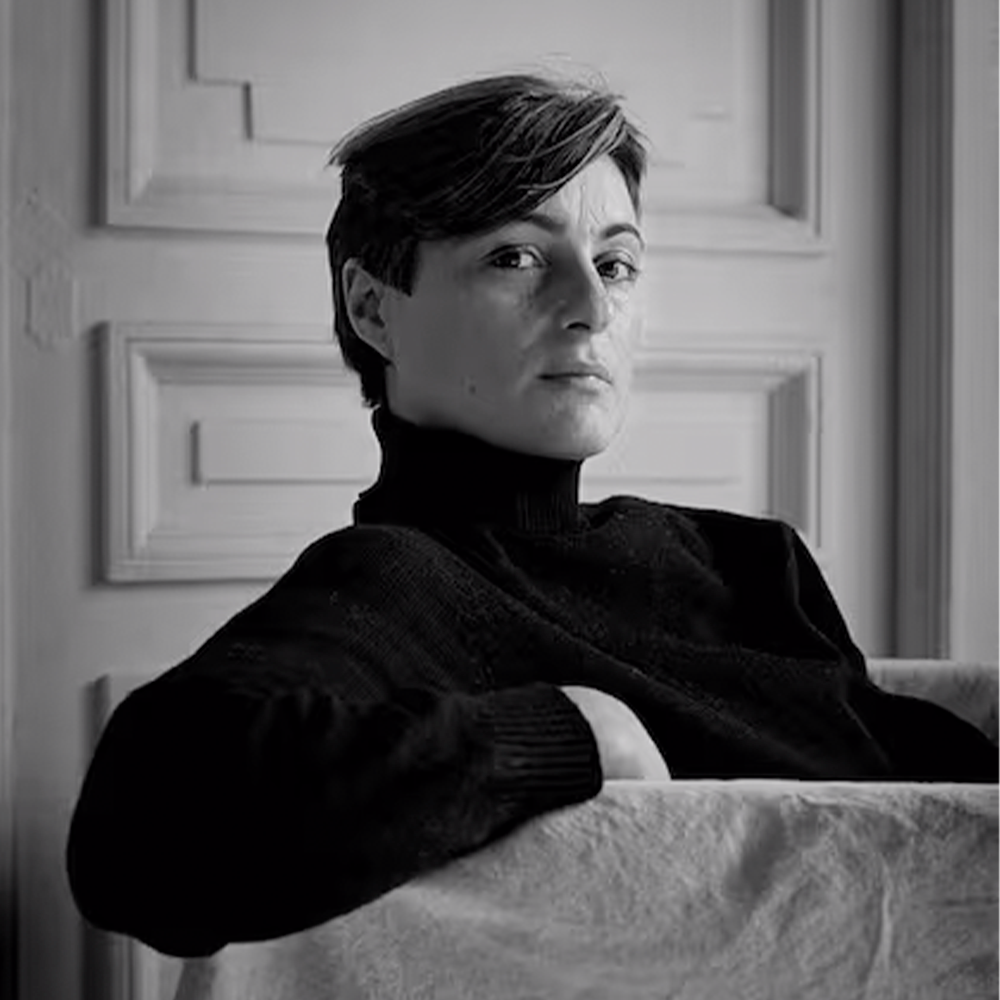
Liliana Maresca
He was born in Avellaneda, Buenos Aires Province, in 1951. He studied at the National School of Ceramics. He took painting classes with Renato Benedetti, drawing classes with Miguel Ángel Bengochea, and sculpture classes with Emilio Renart. In the early 1980s, he began actively participating in the underground art scene of Buenos Aires, in spaces such as Café Einstein and the magazine El Porteño. In addition to organizing and participating in group exhibitions, he collaborated with artists like Ezequiel Furgiuele and the photographer Marcos López. In the early nineties, he exhibited his projects at the Centro Cultural Recoleta and the Casal de Catalunya, Buenos Aires. His works exceed disciplinary modalities and juxtapose in a journey that articulates painting, sculpture, objects, photo-performances, installations, spatial interventions, among others. Of unconventional temperament, he chose atypical spaces for his creations. Many of his works are linked to the neo-dadaism of the sixties when art began to break into everyday life with happenings. In his erotic photographs, Maresca merges photo-performance with the notion of multiple media. He died in Buenos Aires in 1994.
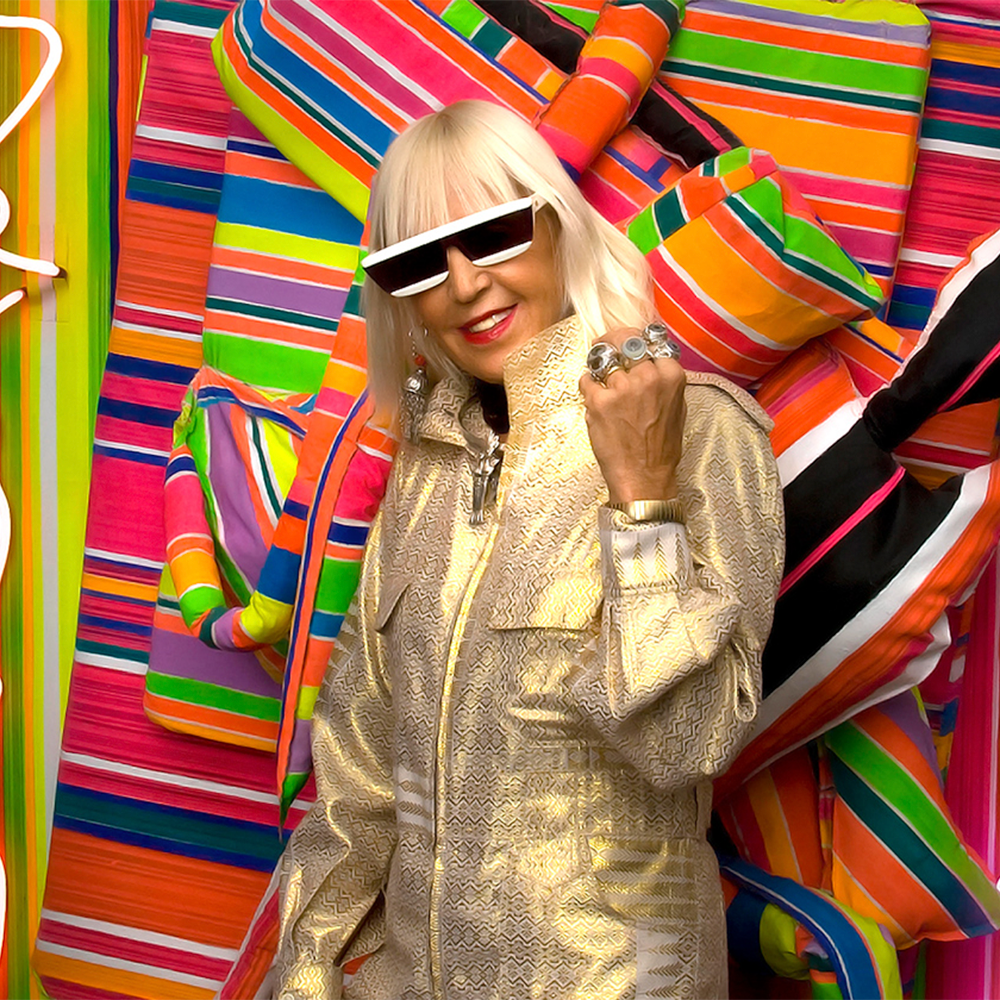
Marta Minujín
He was born in Buenos Aires in 1941. He studied irregularly at the national schools of Fine Arts Manuel Belgrano and Prilidiano Pueyrredón. Between 1961 and 1964, he split his time between Paris and Buenos Aires, thanks to successive scholarships granted by the French government. There, he became associated with the artists of the nouveau réalisme movement. In 1963, he created La Destrucción, his first happening. Upon returning to Buenos Aires in 1964, he won the National Prize from the Torcuato Di Tella Institute. In 1965, he created La Menesunda with Rubén Santantonín, and the following year he traveled to New York, USA, where he developed projects related to mass media. He won the Guggenheim Fellowship with the Minuphone project in 1967. During the seventies, he divided his time between the USA and Argentina. Towards the end of the decade, he developed projects of massive participation such as El Obelisco de pan dulce and El Partenón de libros. In the eighties, he created fragmented sculptures and large installations. In 2017, he was invited to the 14th edition of Documenta, Kassel, Germany, where he presented a version of the Parthenon of forbidden books.
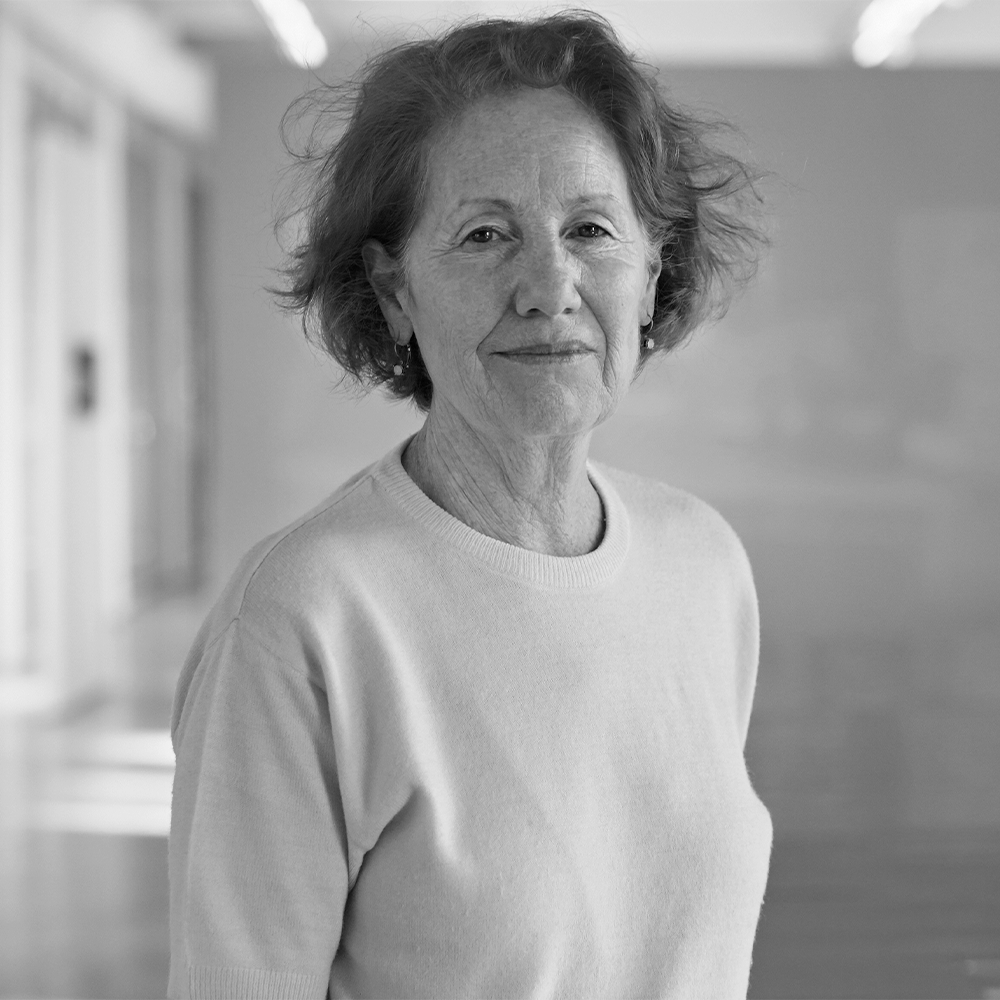
Cristina Piffer
Born in Buenos Aires in 1953. She is an architect and visual artist, graduated from the Faculty of Architecture of the UBA and the Ernesto de La Cárcova Superior School of Fine Arts. She was awarded the National Prize for Artistic Trajectory 2022; the Visual Arts Acquisition Award 8M, promoted by the Ministry of Culture of the Nation (2022); distinguished as Artist of the Year by the Association of Art Critics (2002) and received the Grant from the National Fund for the Arts (2001), among other distinctions. Her extensive production addresses the theme of political violence in 19th-century Argentine history through the survey of historical or literary sources and the exploration of diverse materialities. Her work is part of national and international collections, both public and private, such as the National Museum of Fine Arts (MNBA), the Museum of Modern Art of Buenos Aires (MAMBA), the Museum of Latin American Art of Buenos Aires (MALBA), and the Museum of Contemporary Art of Rosario (Macro).
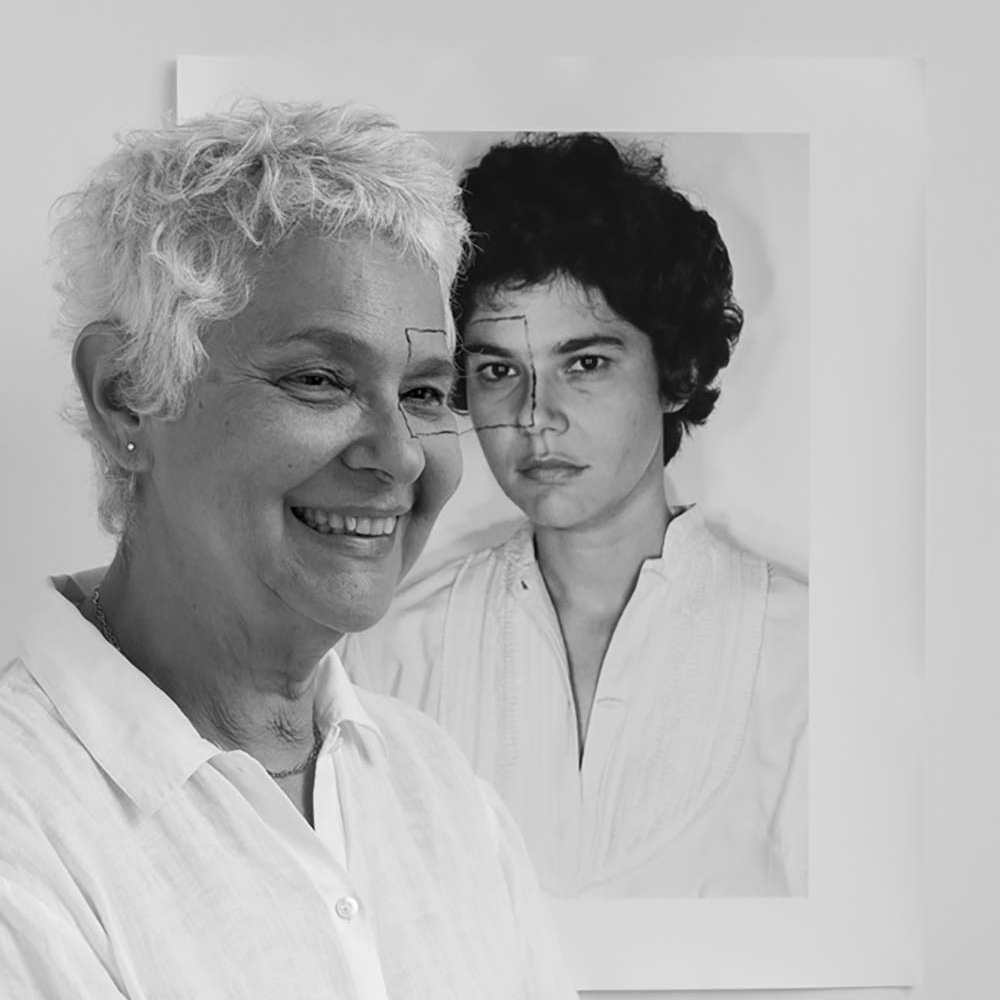
Liliana Porter
Born in Buenos Aires in 1941. She studied at the Manuel Belgrano National School of Fine Arts and at the Prilidiano Pueyrredón Art School. She also attended the engraving workshop at the Ernesto de la Cárcova Superior School, directed during that period by the engraver Fernando López Anaya. From 1958 to 1961, she lived in Mexico City, where she presented her first exhibitions. Porter began showcasing her work in 1959 and has since participated in over 450 exhibitions in 40 countries. Recent solo exhibitions include those at El Museo del Barrio, New York, USA; the Pérez Art Museum, Miami, USA; Luciana Brito Gallery in São Paulo, Brazil; ART OMI in Ghent, New York, USA; the Provincial Museum of Fine Arts Franklin Rawson, San Juan, Argentina; the Zapopan Art Museum, Guadalajara, Mexico, and Galerie Mor-Charpentier in Paris, France, among others. She was awarded the Guggenheim Fellowship in 1980. Her work includes engravings, drawings, toys and dolls, works on fabric, installations, photography, and video in which she explores representation, time, and the relationship with reality.
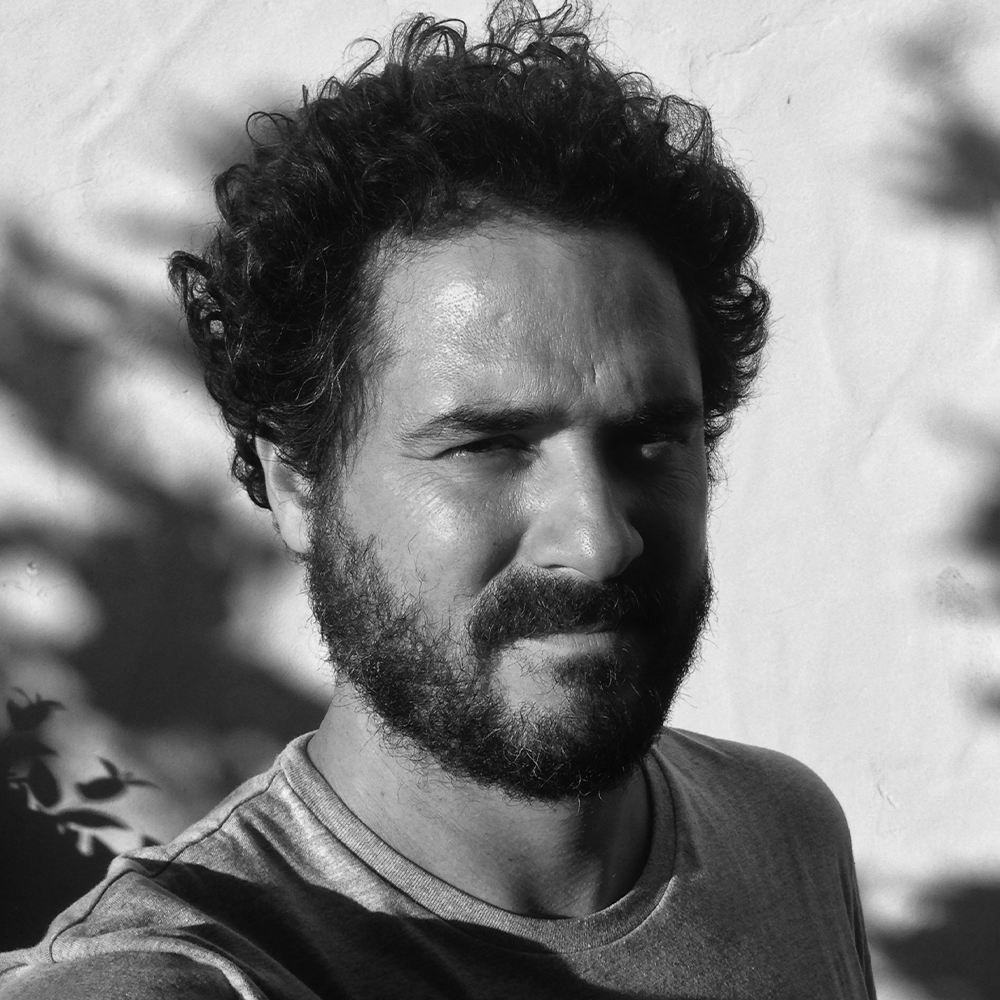
Nicolás Robbio
He was born in Mar del Plata, Buenos Aires province, in 1975. In 1999, he graduated from the Martin A. Malharro Superior School of Visual Arts. He exhibited individually at the Museum of Modern Art (MAM SP) (São Paulo, 2016); Museu da Cidade - Pavilhão Branco (Lisbon, 2015); Galeria Vermelho (São Paulo, 2014); Galerie Invaliden1 (Berlin, 2013), and many other spaces. He participated in group exhibitions around the world, such as at DHC/Art Foundation for Contemporary Art, Montreal (2015); MAC Lyon, Lyon (2014); Simon Lee Gallery, London (2013); Espai d’Art Contemporani de Castelló, Castellón (2013). In 2015, he received the Marcantonio Vilaça CNI SESI SENAI Award – Palácio das Artes – Fundação Clóvis Salgado, Belo Horizonte, Brazil.
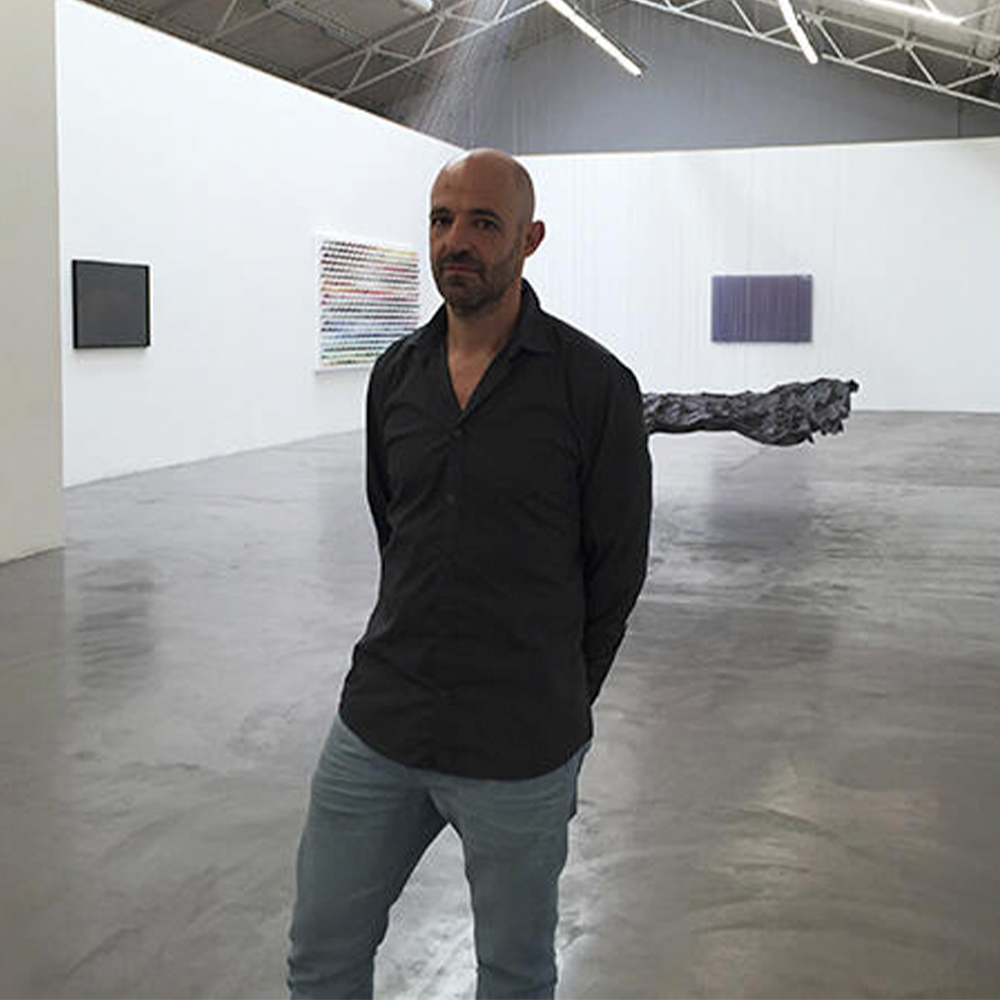
Miguel Rothschild
He was born in Buenos Aires in 1963. Between 1982 and 1987, he studied art at the University of Buenos Aires, and from 1991 to 1994, he continued his studies at the Hochschule der Künste in Berlin, where he was a master student of Rebecca Horn. He works particularly with photography, video, and drawing. His works have been presented in numerous exhibitions worldwide and are part of the collections of the Berlinische Galerie, Staatliche Museen zu Berlin, DZ Bank Collection (Frankfurt am Main), and the Mamba, Museum of Modern Art of Buenos Aires.
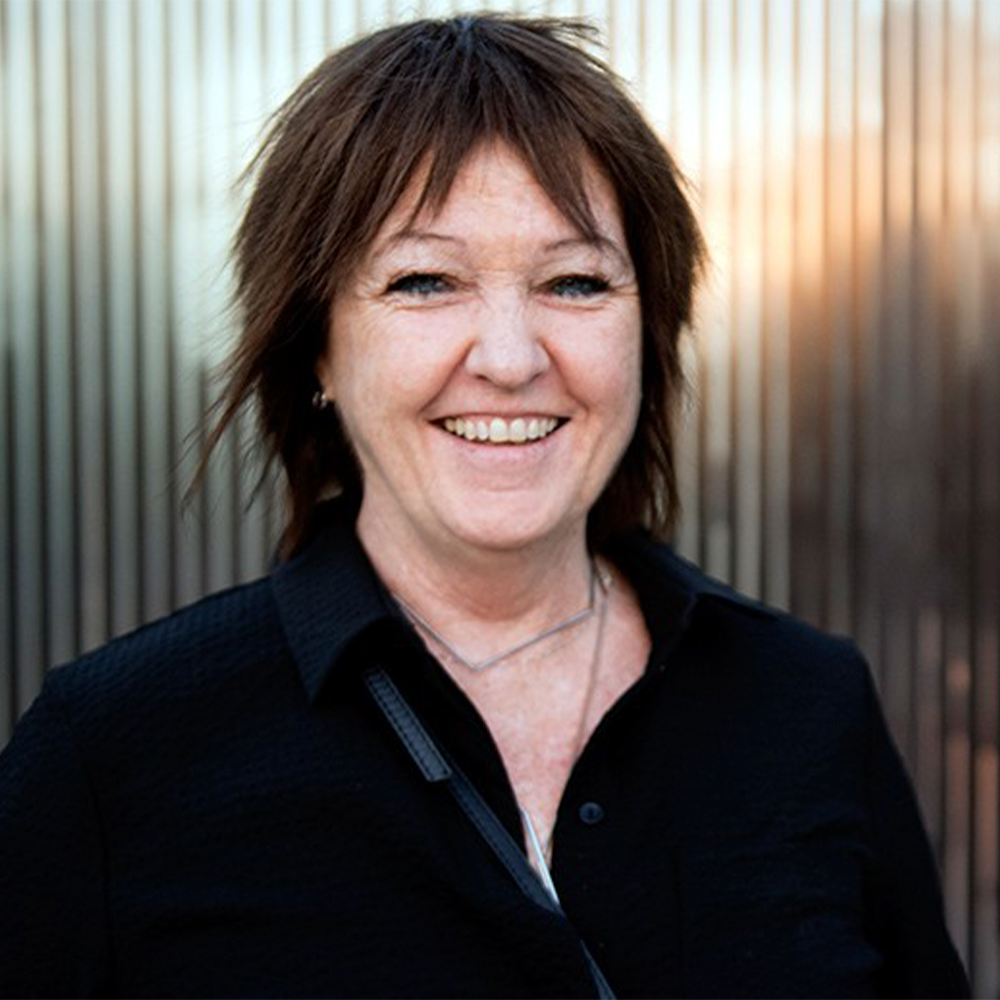
Graciela Sacco
She was born in Rosario, province of Santa Fe, in 1956. She graduated in 1987 with a thesis dedicated to the Argentine avant-garde of the 1960s. The artistic expressions of that decade had established strong ties between artistic experimentation and social commitment, culminating in Rosario, her hometown, with "Tucumán arde," an experience internationally recognized as a milestone of political conceptualism. Her works are related to light and graphics and reflect on political and social violence: transitions, exiles, migrations, and social conflict cores are present in episodes from different eras. She represented Argentina in various international biennials including Shanghai (2004), Venice (2001), Havana (1997 and 2000), Mercosur (1997), and São Paulo (1996), among others. She has been awarded numerous prizes and recognitions, such as Artist of the Year awarded by the Argentine Association of Critics (2001) and the Konex Award (2002-2012), among others. She has published books such as "Nada está donde se cree" (2015), "M2 Volumen I" (2009), "Sombras del Sur y del Norte" (2004), "Imágenes en turbulencia: migraciones, cuerpos y memoria" (2000), "Escrituras solares" (1994). Her works and career have been cataloged in important national and international publications such as America's Society Magazine, Bomb, Art Nexus, Art News, Art in Americas, and the New York Times. She has held numerous solo and group exhibitions in Argentina, England, Germany, France, Switzerland, Israel, the United States, Mexico, Brazil, Cuba, and Peru. Her work is part of public and private national and international collections such as the Mamba (Museum of Modern Art of Buenos Aires, Argentina); Macro (Museum of Contemporary Art of Rosario, Argentina); Bronx Museum in New York (USA); MFAH – Museum of Fine Arts Houston (USA); Museum of Art Fort Lauderdale (USA); Microsoft Collection, Washington (USA); Capitolio Policultural (Porto Alegre, Brazil); Essex University, (Colchester, England), among others. She passed away in 2017.
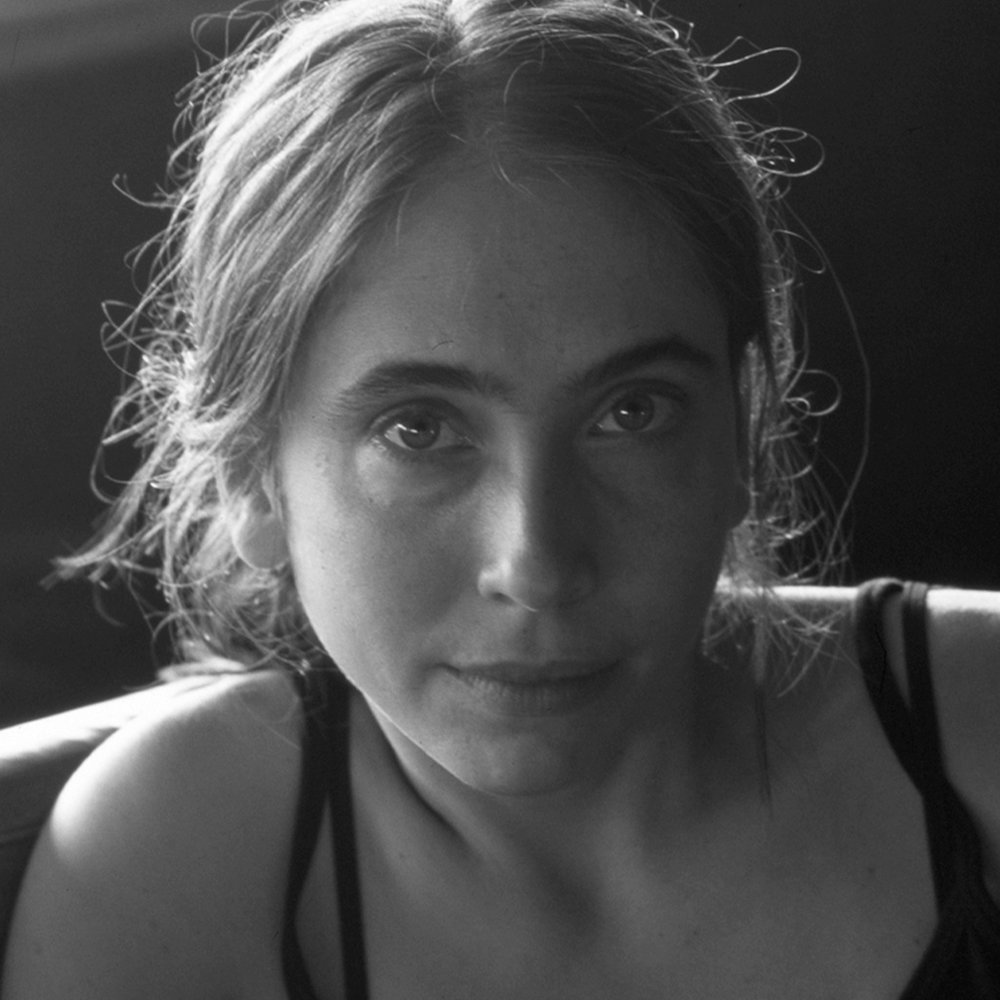
Alessandra Sanguinetti
She was born in New York in 1968. She is a photographer of Argentine-American descent. She has received numerous grants and awards, including from the Guggenheim Foundation, the Hasselblad Foundation, the Sundance Development Grant, the Robert Gardner Peabody Fellowship, and a Rencontres d’Arles Discovery Award. Her publications include "El sexto día," "Las aventuras de Guille y Belinda y el Enigmático significado de sus sueños," "La ilusión de un verano sin fin," "Some say ice," "Le gendarme sur la colline," and "Sorry welcome." She has been a member of Magnum Photos since 2007.
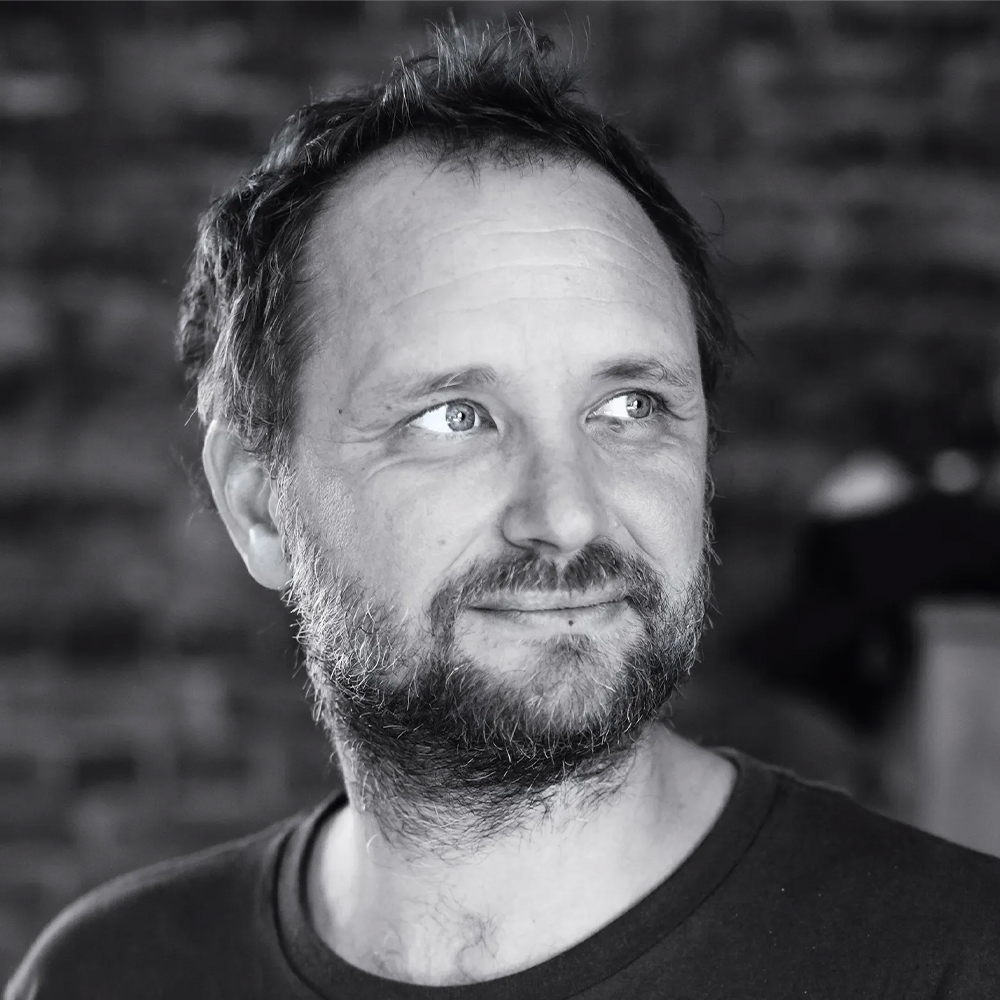
Tomás Saraceno
He was born in San Miguel de Tucumán, Tucumán province, in 1973. He is an architect graduated from the University of Buenos Aires. He pursued postgraduate studies in Art and Architecture at the Ernesto de la Cárcova Superior School of Fine Arts and at the Städelschule, Frankfurt am Main, Germany. In 2009, he attended the International Space Studies Program at NASA. He held numerous solo exhibitions in important international institutions, including the Museo d’Arte Contemporanea di Villa Croce (Genoa, 2014); K21 (Düsseldorf, 2013-2015); Metropolitan Museum of Art (New York, 2012); Maison Hermès (Tokyo, 2012); Hamburger Bahnhof—Museum für Gegenwart (Berlin, 2011); Macro, Museo d’Arte Contemporanea (Rome, 2011); Walker Art Center (Minneapolis, USA, 2009). In 2013, he participated in the central exhibition of the 53rd Venice Biennale, curated by Daniel Birnbaum.
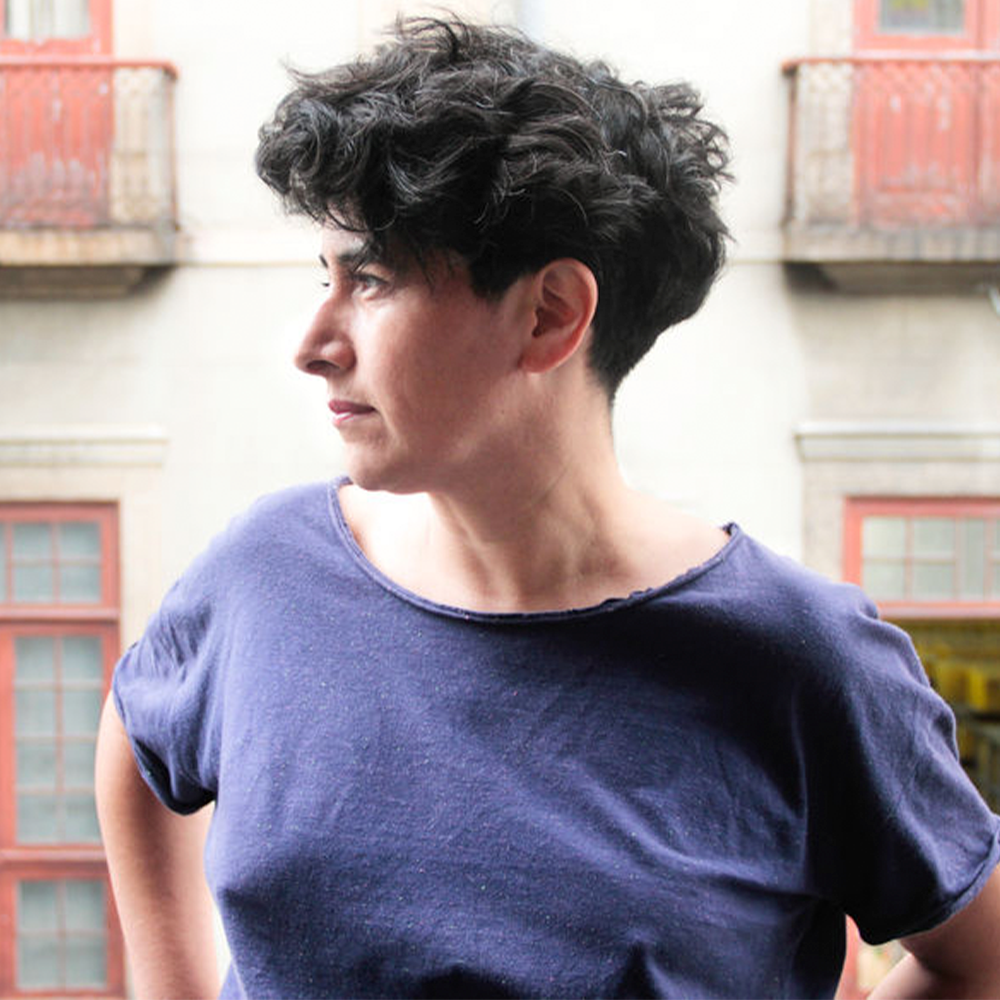
Mariela Scafati
She was born in Buenos Aires in 1973. She studied Graphic Design and Visual Arts Teaching at ESAV, Bahía Blanca, and Visual Arts Teaching specializing in painting. In 1997, she moved to Buenos Aires and participated in the La Cárcova workshop with Pablo Suárez and Tulio de Sagastizábal. She participated in the Kuitca Grant during 2002 and exhibited for the first time at Belleza y Felicidad. She is a co-founder of the Popular Screen Printing Workshop along with Magdalena Jitrik and Diego Posadas. She experimented in the field of dramatic arts with theater works, conducted the "Special Walk", the puppet company "Yotiteretú" with Fernanda Laguna, the action and print "Hasta la Victoria Ocampo!", Kamishibai, and "In search of the unnamed painting" with Orquesta Roja in 2009.
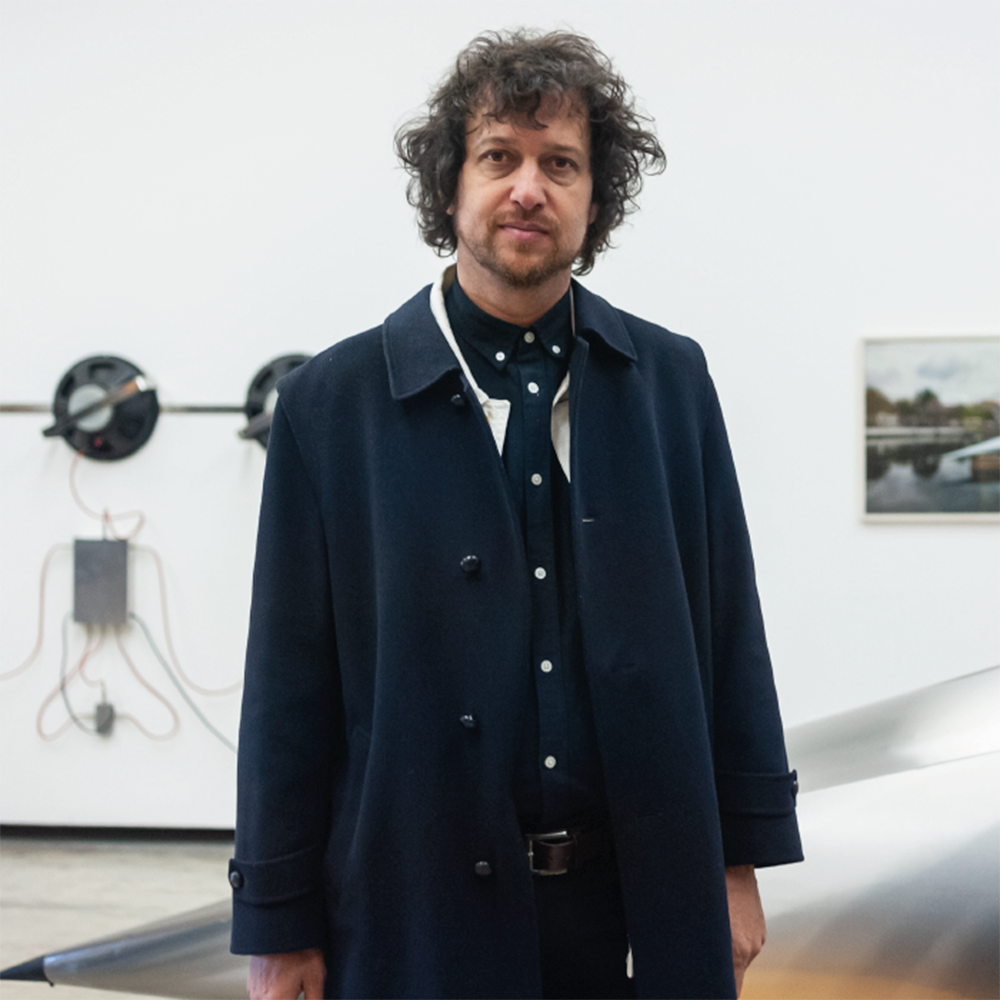
Juan Sorrentino
He was born in Resistencia, Chaco, in 1978. He is a sound artist, curator, and teacher. He creates works and installations exploring concepts of sound language in a poetic and collective imagination context. He holds a degree in Composition from the National University of Córdoba (Argentina) and has a postgraduate degree in Technology and Video from Mecad-Aesdi in Barcelona. Director of Monte Residencia, in Chaco. He has participated in numerous solo and group exhibitions such as Whitechapel Gallery (London), Bonniers Konsthall (Sweden), MAAT (Lisbon), Sinne (Finland), Argos (Belgium), MediaLab Prado (Madrid), Espacio Marzana (Bilbao), Círculo de Bellas Artes (Madrid), Casa de América (Madrid), Sonic Spring (New York), Verge (California), Pontificia Universidad Javeriana (Colombia), EAC (Uruguay), LUM (Peru), Galería Macchina (Chile), Museo Olga Costa (Mexico), Fortabat (Buenos Aires), CCK (Buenos Aires), and Imago (Buenos Aires), among others. He teaches in the Bachelor's Degree in Electronic Arts at Untref and in the Bachelor's Degree in Combined Arts Fadycc UNNE, Chaco. He has received numerous awards and his works are part of museums and private collections.
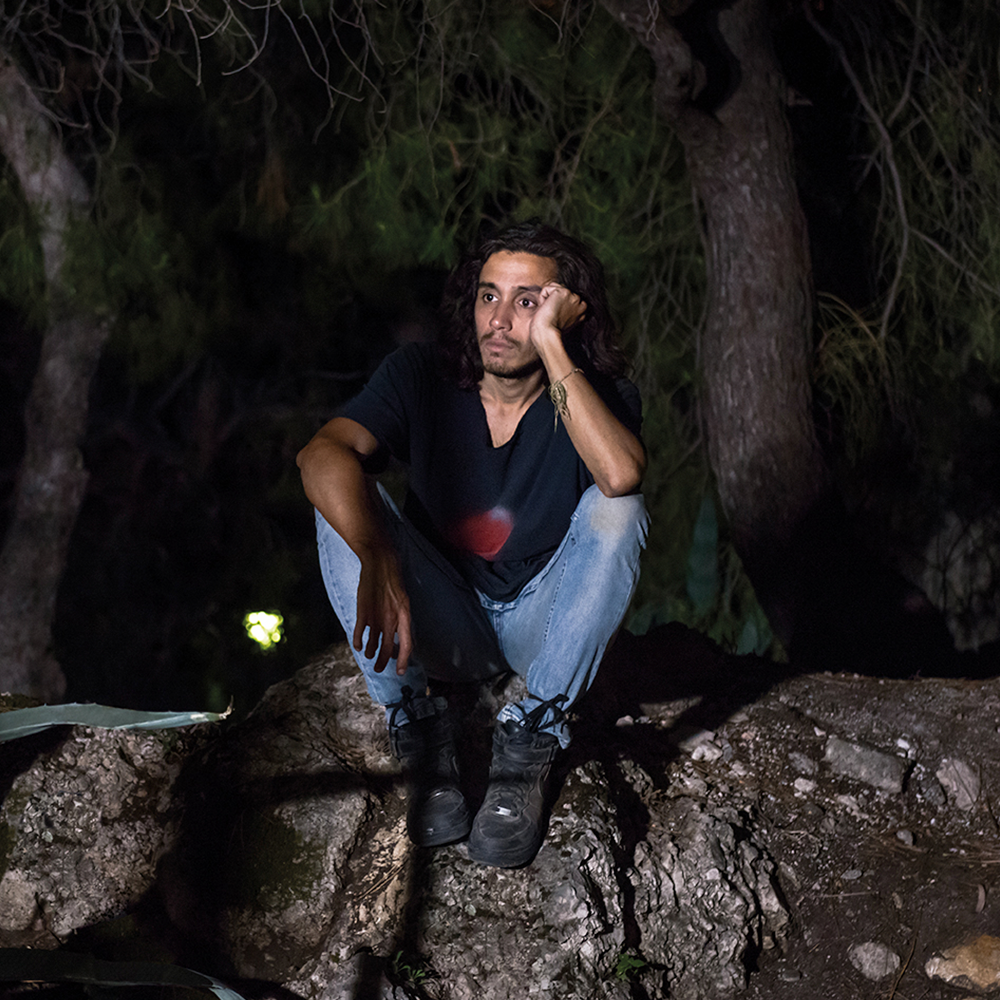
Adrián Villar Rojas
He was born in Rosario, province of Santa Fe, in 1980. He has received several awards such as The Zurich Art Prize at the Museum Haus Konstruktiv (2013) and the 9th Benesse Prize at the 54th Venice Biennale (2011); he received the scholarship for young artists from the Nuevo Banco de Santa Fe (2006) and won the first prize at the Bahía Blanca Biennial awarded by the Museum of Contemporary Art of Bahía Blanca (2005). He has exhibited his work in solo shows in cities such as New York, Switzerland, London, Belgium, São Paulo, Paris, Bogotá, Berlin, and Buenos Aires, and also in group shows in South Korea, Athens, Moscow, Madrid, Kabul, Kassel, Istanbul, Venice, and Mexico.